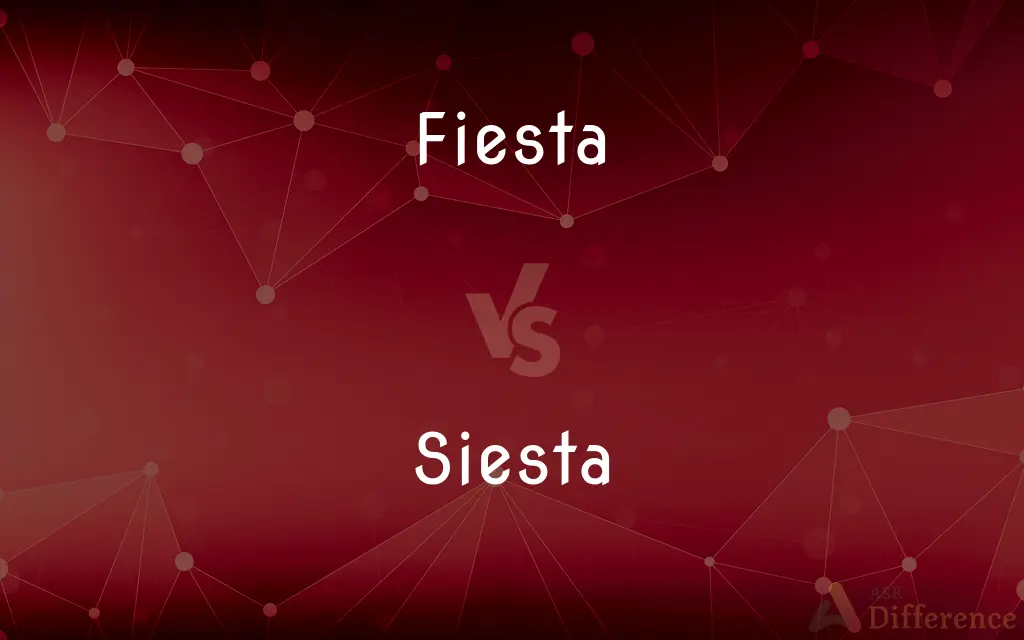Fiesta vs. Siesta — What's the Difference?
Edited by Tayyaba Rehman — By Urooj Arif — Updated on February 23, 2024
Fiesta refers to a festive celebration or party, often with cultural significance, while siesta is a traditional short nap or rest taken in the early afternoon, especially in hot climates.

Difference Between Fiesta and Siesta
Table of Contents
ADVERTISEMENT
Key Differences
Fiesta and siesta are terms deeply embedded in Spanish culture, each representing different aspects of life and social customs. A fiesta is typically a lively, communal gathering with music, dancing, and food, marking special occasions or religious events. In contrast, a siesta is a period of rest or nap, usually taken after the midday meal to escape the hottest part of the day, reflecting a slower-paced lifestyle that values rest and rejuvenation.
Fiestas are celebrated with much enthusiasm and are an integral part of community life, showcasing local traditions, costumes, and cuisine. They often include public festivities, parades, and sometimes religious ceremonies. Siestas, on the other hand, are more of a personal or family tradition, where businesses shut down and people retreat to their homes for a quiet rest, indicating a cultural attitude towards work-life balance and the importance of relaxation.
The concept of a fiesta highlights the social and celebratory aspects of culture, encouraging community bonding and joy. Siestas, meanwhile, underscore the value placed on health, well-being, and the adaptation to natural rhythms, such as climate and daylight hours.
Fiestas can attract tourists and foster cultural exchange, they also serve to strengthen local identity and heritage. Siestas, although less visible to the external observer, contribute to a lifestyle that prioritizes personal well-being and productivity through rest.
The timing of these customs also reflects their nature; fiestas are often planned events that can last several days, involving extensive preparation and participation. Siestas are a daily occurrence, short in duration but significant in their contribution to the overall rhythm of life in siesta-practicing communities.
ADVERTISEMENT
Comparison Chart
Definition
A celebration or party, often with cultural significance.
A short nap or rest, typically taken in the early afternoon.
Origin
Spanish, meaning "feast" or "festival".
Spanish, meaning "rest" or "nap".
Purpose
To celebrate special occasions, cultural events, and communal joy.
To rest and rejuvenate during the hottest part of the day.
Timing
Can occur at any time of the day, often extending into the night.
Usually after the midday meal, lasting about an hour or two.
Social Aspect
Highly communal and public, involving local or wider communities.
Personal or family-oriented, with businesses often closing.
Compare with Definitions
Fiesta
A religious festival commemorating a patron saint.
The fiesta of San Juan features night-long bonfires and fireworks.
Siesta
A rest period in the workday in some countries.
The shop closes for siesta and reopens later in the afternoon.
Fiesta
An event marked by feasting and merrymaking.
The streets were filled with music and laughter during the fiesta.
Siesta
A short afternoon nap, especially in hot climates.
After lunch, we took a siesta to escape the midday heat.
Fiesta
A party or gathering with festive activities.
We're hosting a garden fiesta for her birthday.
Siesta
A cultural tradition of taking a midday break.
The concept of siesta is integral to their way of life.
Fiesta
A public celebration with parades and performances.
The town's annual fiesta attracted visitors from neighboring regions.
Siesta
A rest or nap, especially one taken after the midday meal.
Fiesta
A cultural or community celebration.
The local fiesta showcases traditional dances and costumes.
Siesta
A practice aimed at rejuvenation and productivity.
Adopting a siesta into my routine has improved my afternoon focus.
Fiesta
An elaborate party (often outdoors)
Siesta
An afternoon rest or nap, especially one taken during the hottest hours of the day in a hot climate
Everyone had a siesta for a few hours
Fiesta
(in Spanish-speaking countries) a religious festival
The yearly fiesta of San Juan
Siesta
A quiet time in towns and cities when businesses close.
The city streets are almost empty during siesta time.
Fiesta
A festival or religious holiday, especially a saint's day celebrated in Spanish-speaking countries.
Siesta
A siesta (from Spanish, pronounced [ˈsjesta] and meaning "nap") is a short nap taken in the early afternoon, often after the midday meal. Such a period of sleep is a common tradition in some countries, particularly those where the weather is warm.
Fiesta
A celebration or party.
Siesta
A nap, especially an afternoon one taken after lunch in some cultures.
Fiesta
A religious festival.
Siesta
(intransitive) to take a siesta; to nap.
Fiesta
A festive occasion.
Siesta
A short sleep taken about the middle of the day, or after dinner; a midday nap.
Fiesta
Among Spanish, a religious festival; a saint's day or holiday; also, a holiday or festivity.
Even . . . a bullfight is a fiesta.
Some fiesta, when all the surrounding population were expected to turn out in holiday dress for merriment.
Siesta
A nap in the early afternoon (especially in hot countries)
Common Curiosities
What is a siesta?
A siesta is a short nap or rest taken in the early afternoon, particularly in hot climates, as part of a daily routine.
What is a fiesta?
A fiesta is a festive celebration or party, often marked by cultural significance and communal activities.
Are fiestas unique to Spanish culture?
While rooted in Spanish culture, the concept of fiestas has been adopted and adapted by various cultures around the world.
Why do people celebrate fiestas?
Fiestas are celebrated to commemorate special occasions, cultural events, and foster community bonding and joy.
How do fiestas impact local communities?
Fiestas can strengthen community ties, boost local economies, and preserve cultural traditions and heritage.
Is the siesta still relevant today?
In many cultures, the siesta remains a valued tradition for its benefits to health and productivity, though modern work schedules have affected its practice.
Can tourists participate in fiestas?
Tourists are often welcomed to observe and sometimes participate in fiestas, offering a rich cultural experience.
Is a siesta beneficial for everyone?
While beneficial for many, the need for a siesta can vary based on individual health, lifestyle, and work demands.
Why do people take siestas?
Siestas are taken to rest and rejuvenate during the hottest part of the day, reflecting a lifestyle that values well-being and productivity.
Is the siesta practiced worldwide?
The siesta is most common in Spanish-speaking countries and some Mediterranean cultures, though its concept has gained interest globally.
How long does a siesta typically last?
A siesta typically lasts between 20 minutes to an hour or two, depending on cultural practices.
How does the siesta affect business hours?
In regions where the siesta is practiced, businesses may close in the early afternoon and reopen later in the day.
Are there specific foods associated with fiestas?
Yes, fiestas often feature special foods and drinks that are part of the celebration's traditions and cultural expressions.
Can fiestas have religious significance?
Yes, many fiestas have religious underpinnings, celebrating patron saints or religious holidays.
Do fiestas occur at specific times of the year?
Fiestas can occur throughout the year, often tied to specific dates, seasons, or religious calendars.
Share Your Discovery

Previous Comparison
Cop vs. Drop
Next Comparison
Foolish vs. StupidAuthor Spotlight
Written by
Urooj ArifUrooj is a skilled content writer at Ask Difference, known for her exceptional ability to simplify complex topics into engaging and informative content. With a passion for research and a flair for clear, concise writing, she consistently delivers articles that resonate with our diverse audience.
Edited by
Tayyaba RehmanTayyaba Rehman is a distinguished writer, currently serving as a primary contributor to askdifference.com. As a researcher in semantics and etymology, Tayyaba's passion for the complexity of languages and their distinctions has found a perfect home on the platform. Tayyaba delves into the intricacies of language, distinguishing between commonly confused words and phrases, thereby providing clarity for readers worldwide.
















































